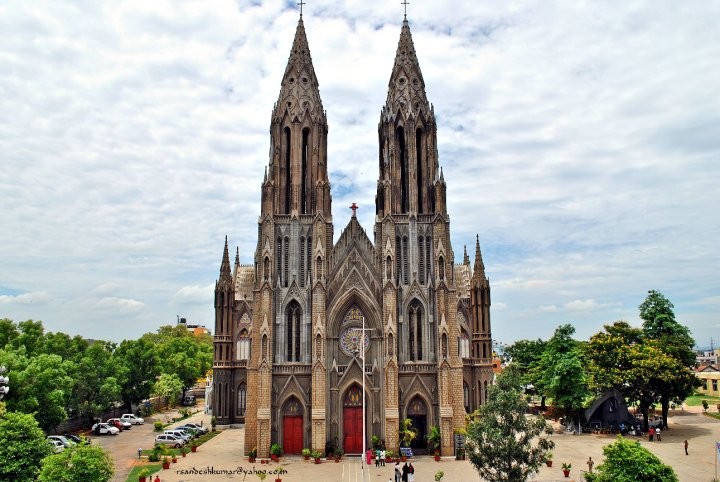“50 Stars of Christmas”: St Philomena Church, Mysuru – Testimony of Secular outlook of Mysuru rulers
India is a pluralistic country with thousands of dialects and many faiths. All festivals are celebrated with equal gaiety and fervor. We just finished celebrating Diwali and the planning for the Christmas has begun. Planning for the Prayers, feasts and carols across the Churches have started.
It is said that Christianity has been introduced to the nation in 52 AD by Thomas the Apostle, Christianity now has about 28 million followers in India. The religion has left an indelible mark on the cultures, traditions and architecture of India. Beautifully embellished churches adorn every city and towns in the country. St. Thomas himself established a church or two in Kerala but he inspired many to construct these Christian places of worship across the country. Colonization was a significant era of building churches as the Dutch, Portuguese, French and British people brought with them new styles of architecture, which resulted in delivering India with exquisite churches that are a must see in India.
Religion World will take you on a virtual tour, with a beautiful Church a day beginning today till the Christmas! The country is dotted with enticing church architectures. In fact, it is wonderful to explore them as heritage structures as well. While ancient churches attract visitors for their rustic charm, the new ones shine in contemporary design. Especially, during Christmas, these churches look colourful and flamboyant. Some of them are also the landmark destinations in India. Its going to be interesting to explore such wonderful places that are filled with a rich history and architecture! Let us take a virtual tour around the beautiful churches in India with this series.
St. Philomena’s Church,
The St. Philomena’s Church is Asia’s second largest church. It was constructed to pay tribute to the Catholic Saint and martyr of Roman Catholic Church, Saint Philomena. The foundation for the church was laid in the year 1933. After the construction had gone on for about eight years, the church started functioning in the year 1941. The remains of Saint Philomena have been preserved here and are present even today.
History
The Saint Philomena’s Church in Mysore is one of the oldest churches in India. It is over 200 years old. Initially over 250 years ago there was a small church in its place. When the capital of Mysore state was moved from Srirangapatnam to Mysore city in 1799, many British officers and soldiers came and settled down in Mysore. The Maharaja Krishnaraja Wodeyar III realized the need for a Christian church for these people. So the Maharaja gave them a small plot of land on the Mysore-Bangalore Road and a little church came up there. As the city expanded and the Christian population of the city increased there was a need for a larger church.

Saint Philomena Cathedral made plans to build a larger church and thus came into existence the famous Saint Philomena Church of Mysore. Maharaja Krishnaraja Wodeyar IV laid the foundation of the new church on October 28th, 1933 that was to be built in the place of the small church built by his grandfather. A Frenchman named Daly designed the church. The floor plan of the cathedral is in the form of a cross. The long part of the cross is the ‘nave’, which is the congregation hall. The two arms of the cross are the ‘transepts’. The fourth part containing the altar and the choir is the ‘crossing’.
Architecture
It has been built in the Gothic style with beautiful stain glass windows and lofty towers. The illuminated church in the evening is a wonderful site not to be missed. A priceless French statue of a celebrated Greek saint in a German cathedral located in the heart of India, is how some have described Mysore’s famous Saint Philomena’s Cathedral
Located in the north of the city of Mysuru, on Cathedral Road, is Saint Philomena’s Cathedral, among the most majestic churches in India. Drawing inspiration from Germany’s Cologne Cathedral, this colossal church built in the neo-Gothic style was designed by the Reverend Rene Feuge.

The twin spires of the Cathedral, 175 feet in height, are seen from miles around making it a distinctive city landmark. The main hall or nave of the cathedral can seat up to 800 people and is as exquisitely conceived as the ornately crafted exterior with beautiful stained glass windows depicting scenes from the birth of Christ, the Last Supper, the Crucifixion, the Resurrection and the Ascension of Christ. The cathedral has a crypt that houses a beautiful statue, acquired from France, of Saint Philomena, a 3rd century saint from Greece.
The Holy Mass is performed daily in Kannada, Tamil and English at the table in the sanctum sanctorum. Behind this is an exquisite marble altar on which the statue of Saint Philomena is placed. There is also an idol of Christ lying in his sacred wounds. Above the sanctum there are lovely stained glass windows from France with painting depicting the birth of Jesus Christ, the Last Supper, the Crucifixion and the Resurrection. The part of the church that is most attractive is the towers or spires. These towers resemble that of a cathedral in Cologne in Germany and those of St. Patrick’s Church in New York. The two spires are 175 feet tall.

The entire church is built in the Gothic style is one of the largest Cathedrals in South Asia. The Church has the relic of the 3rd century Saint Philomena that is in a beautiful catacomb that is below the main altar. The construction of the church was completed under Bishop Rene Fuga’s supervision. At that time Thamboo Chetty, was the Huzur Secretary to the Maharaja of Mysore, heard about the greatness of Saint Philomena and obtained a relic of the saint from Peter Pisani, Apostolic Delegate of the East Indies in 1926. After obtaining the relic it was handed over to Fr. Cochet. The next year a new state of Saint Philomena was brought from France. Statues of St. Philomena can be found on the altar and beneath the ground are her preserved remains. The hall of the church is vast and can house up to 800 people at once.
St Philomena
The story of Saint Philomena dates back to the 3rd century A.D. Philomena was the daughter of the monarch of a small state in Greece. Her parents were childless. They prayed to God and asked Him to bless them with a child and promised to convert to Christianity if their wish was granted. The next year Philomena was born to them. Even in her childhood Philomena showed signs of piety. When Philomena was 13 years’ old her father took her to Rome to obtain the favour of Emperor Diocletion. The Emperor was enthralled by her beauty and wanted to marry her. But she refused and vowed to give herself to God. As she refused to marry the Emperor she was tortured and beheaded in Rome.

But people’s devotion for her spread near and far and she was given Sainthood. There are a number of churches dedicated to her all over the world. Today the church in Mysuru stands as a monument to the secular outlook of the Mysore rulers. It is no longer just a religious place but has become a major tourist attraction in Mysore. There is an orphanage on the premises of the church that is run by the church. The church is located at a distance of 3kms from the city bus stand 2km from the Palace. The church is open from 8am to 6pm. Holy Mass is held in the morning and evening. Special masses are held on Sundays and on festivals. An Annual Feast is held on August 11th each year.









